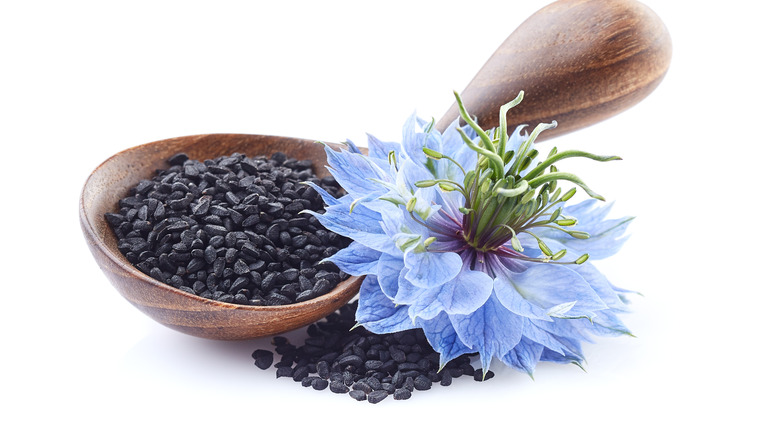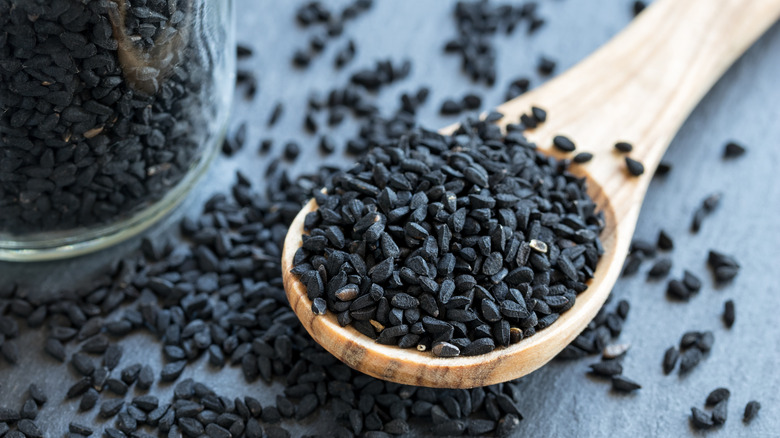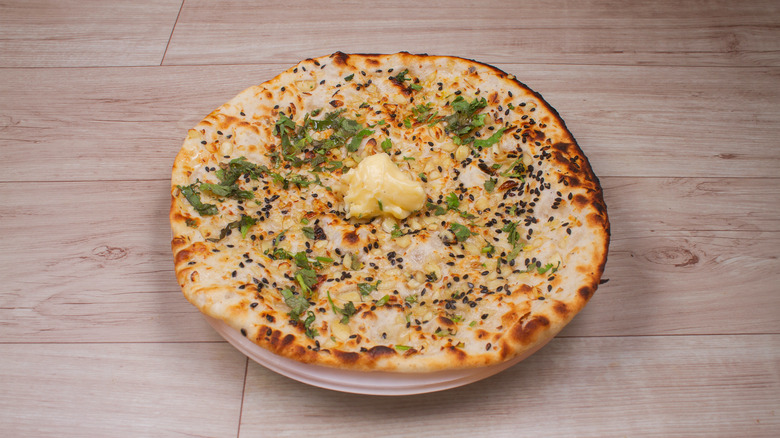Everything You Need To Know About Nigella Seeds
Seeds are perhaps the most underutilized ingredient in the kitchen. Not only can seeds bring a lot to the plate in terms of flavor, color, and texture, but they are also a powerhouse of nutrients. While some seeds like flax, chia, pumpkin, and sunflower are certainly more popular than others, the likes of nigella seeds are yet to be as sought-after in everyday cooking, which is a shame.
Nigella seeds are packed with antioxidants that can protect against diseases like cancer and diabetes, according to Healthline. They have also been associated with reduced inflammation. A study published in the National Library of Medicine found the seed's antibacterial properties to be on par with standard drugs used for infections among babies. They can regulate blood sugar levels, protect the liver from damage, and are particularly effective at reducing bad LDL cholesterol. In Northern Africa, where the Nigella sativa plant is native, nigella seeds have been used for fever, cough, headache, influenza, asthma, and eczema since ancient times.
Besides their health benefits, nigella seeds are used for their flavor, texture, and appearance in several parts of the world. With a little help, they can easily upgrade everyday meals.
What are nigella seeds?
Nigella seeds, often mistaken for caraway seeds, black onion seeds, or black sesame seeds due to their black color and tiny teardrop shape, originate from the Nigella sativa plant. This plant belongs to the Ranunculaceae family, which includes flowering plants like the buttercup. Though believed to have originated in Southeast Asia, the Nigella plant's seeds have been utilized in Greece, Egypt, Africa, and the Middle East, as well as India, where they are known as kalonji.
Ranking among some of the oldest seeds used as spices, the little black nigella seeds are believed to have been discovered in Tutankhamun's tomb, which is over 3,000 years old. The Bible's Old Testament also mentions nigella seeds. Even the Prophet Muhammad is said to have spoken highly of nigella seeds due to their supposed health properties.
With a flavor that can range from bitter to nutty, nigella seeds taste faintly of oregano, black pepper, burnt onion, sesame seeds, and poppy seeds. Their crunchy texture provides an excellent contrast to soft foods, and they are often incorporated into warm, chewy naan breads.
How to use nigella seeds?
Nigella seeds are a common ingredient in Indian, North African, and Middle Eastern recipes, where they are often added on top of curries, rice or lentil-based dishes, stir-fries, vegetables, and pickles. In addition to being a popular accompaniment to Indian naans, nigella seeds are widely enjoyed as bread toppers on Turkish flatbreads and various other breads around the world. Even culinary mogul Nigella Lawson uses these seeds to top her fluffy flatbreads and fragrant pilafs. Nigella seeds are part of the five-ingredient blend — alongside fennel, cumin, fenugreek, and mustard seeds — that makes up the Bengali panch phoron, a spice blend that is essential to several dishes in India and Bangladesh.
Once you acquire a taste for nigella seeds, it will be much easier to use them beyond regional specialties and into everyday cooking. Raw nigella seeds, lightly toasted to release their natural oils, can be used much like sesame seeds on eggs, pancakes, oatmeal, and yogurts. You can add their oniony flavor to homemade bagels and crackers, or use them for their nutty crunch in salads, stir-fries, roasted vegetables, and dips. Nigella seeds can also be ground into a fine powder and incorporated into spice blends for flavor-packed curries. The possibilities are truly endless.



